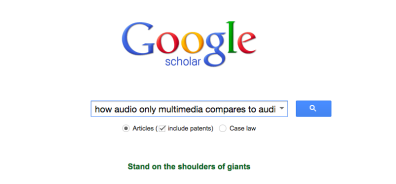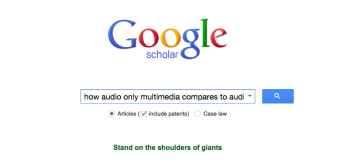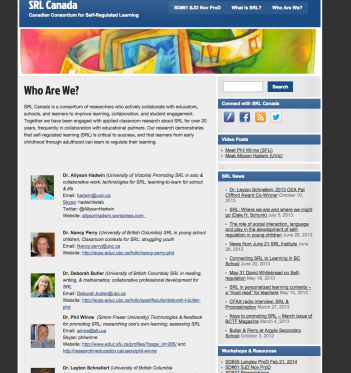My #LearningProject
My #learningproject this term for #EDCI569 was to learn more about Self-Regulated Learning (SRL) in the Intermediate Classroom. My understanding at the beginning of this project was pretty basic. Prior to last summer, I had many preconceived ideas about what SRL was based on my experiences. Last summer, I was introduced to the idea that SRL was so much more than just behaviour management. I reflected on this realization in my blog post, The Case for SRL in the Elementary Classroom. This realization captured my interest. So this term, when I was given the opportunity to learn something of my choice, I chose to do research on how SRL might look in the intermediate classroom.
Another important aspect of my #learningproject was to learn how to do scholarly research and in the end, work towards writing a literature review on the topic. On this aspect, I have taken time to learn specifics about research such as learning how to do online academic searches, accessing the library, connecting with scholars, and writing a literature review. My hope is that this part of my #learningproject will help others in their journey as a graduate student conducting research in the field.
Overview of my #learningproject journey:
Here is a brief overview of my journey in the last three months learning about SRL.
- Introduction
- Learning about how to do research and a literature review
- Networking with Experts
- Reflections on my learning and practice in regards to SRL
- Summary of #learningproject
Where I am at
There are three ways in which I have found my #learningproject has changed me.
First, I feel much more informed and connected to the research field of SRL. I have made numerous connections with leading experts around the world. I have read a variety of research based articles and blogs, and reflected on their implications in the classroom. Through Twitter, Google+, and email, I feel as though I have created a basic network of people and resources for me to easily tap into throughout the rest of my journey in this #learningproject.
Secondly, I have noticed that my thinking about learning has begun to change. I have realized that in essence, I have been learning about learning. This excites me, because it connects directly to an inspiring quote that I am fond of in Richardson’s (2012) book Why School?. “The illiterate of the 21 century will not be those who cannot read and write. The illiterate will be those who cannot learn, unlearn, and relearn” (Herbert Gerjuoy as cited in Richardson, 2012). In regards to myself, I am constantly assessing my own strategies and methods to learn. I am acknowledging my own strengths and weaknesses about how I learn. When I am teaching in my class, I am constantly thinking about the barriers to learning that my students are facing, and how I can begin to help them take some ownership over overcoming these barriers.
Finally, as my thoughts have begun to change, I have noticed my practice also changing. An example of this can be found at my blog post, SRL in the Classroom. I constantly point out when my students are displaying strategies of monitoring and assessing their learning. I find myself discussing these things, and my own learning, with my students, explicitly teaching them through modelling and class discussion. I have begun to notice that a few of my students are latching on to the idea that they can monitor and change their learning behaviors. This is the most exciting outcome of my #learningproject!
Where Am I Going?
My #learningproject has really only just begun. The hope is that this project forms a foundation for me to take further research action in developing a resource for teachers to implement SRL in the classroom. As my research and learning forms my understanding of SRL and how it is best implemented in the classroom, so does my vision for what my final resource will look like. Initially, I imagined it to be a simple resource that gives teachers the opportunity to teach SRL as a separate unit. Now I realize that SRL is so interwoven into learning that it should not be separated out as it’s own entity. This week, as I read Daniel Thompson’s blog (2015), Misconceptions of Self-Regulated Learning Implementation, I was struck by his quote by Dr. Stuart Shanker, “Self-regulation is a process and not a packaged program that comes complete with a predetermined set of ‘regulating tools’.” I need to be very careful as I begin this next part of my #learningproject that I do not created a packaged program but rather a resource that encourages the use of SRL strategies in all aspects of learning within school and out.
“Therefore, SRL is not an ‘add-on’ to what we do in class. It is simply capitalizing on student’s dispositions, wonderings and inquiries, while helping them develop new strategies to navigate the process successfully.” (Thompson, 2015)
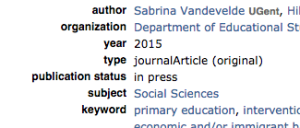

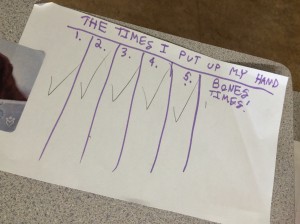
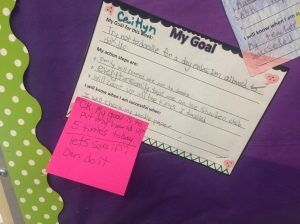
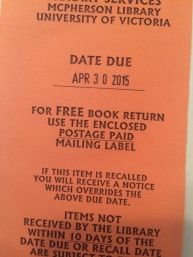 I wrote to inquire why this was. It turns out that UVIC has a policy that all students should have a chance to access every book. So if someone requests the book while you have it, the library will ask for it back. So you are only guaranteed 7 days with the book. Upon closer look of the return slip, I realized that this was written clearly on it. I find this very frustrating because of the uncertainty of how long you can have a book. When I went to university, we got to borrow a book from the library for 3 weeks. I preferred this because we could be certain how long we would have it for and plan our projects around that. If no one had requested it, we could take it out for another 3 weeks. Unfortunately, this has put a big damper on my initial excitement of borrowing books from the library.
I wrote to inquire why this was. It turns out that UVIC has a policy that all students should have a chance to access every book. So if someone requests the book while you have it, the library will ask for it back. So you are only guaranteed 7 days with the book. Upon closer look of the return slip, I realized that this was written clearly on it. I find this very frustrating because of the uncertainty of how long you can have a book. When I went to university, we got to borrow a book from the library for 3 weeks. I preferred this because we could be certain how long we would have it for and plan our projects around that. If no one had requested it, we could take it out for another 3 weeks. Unfortunately, this has put a big damper on my initial excitement of borrowing books from the library.